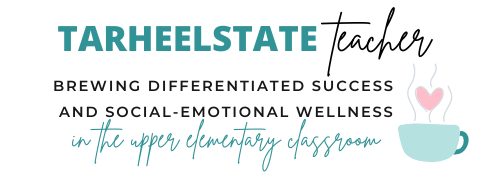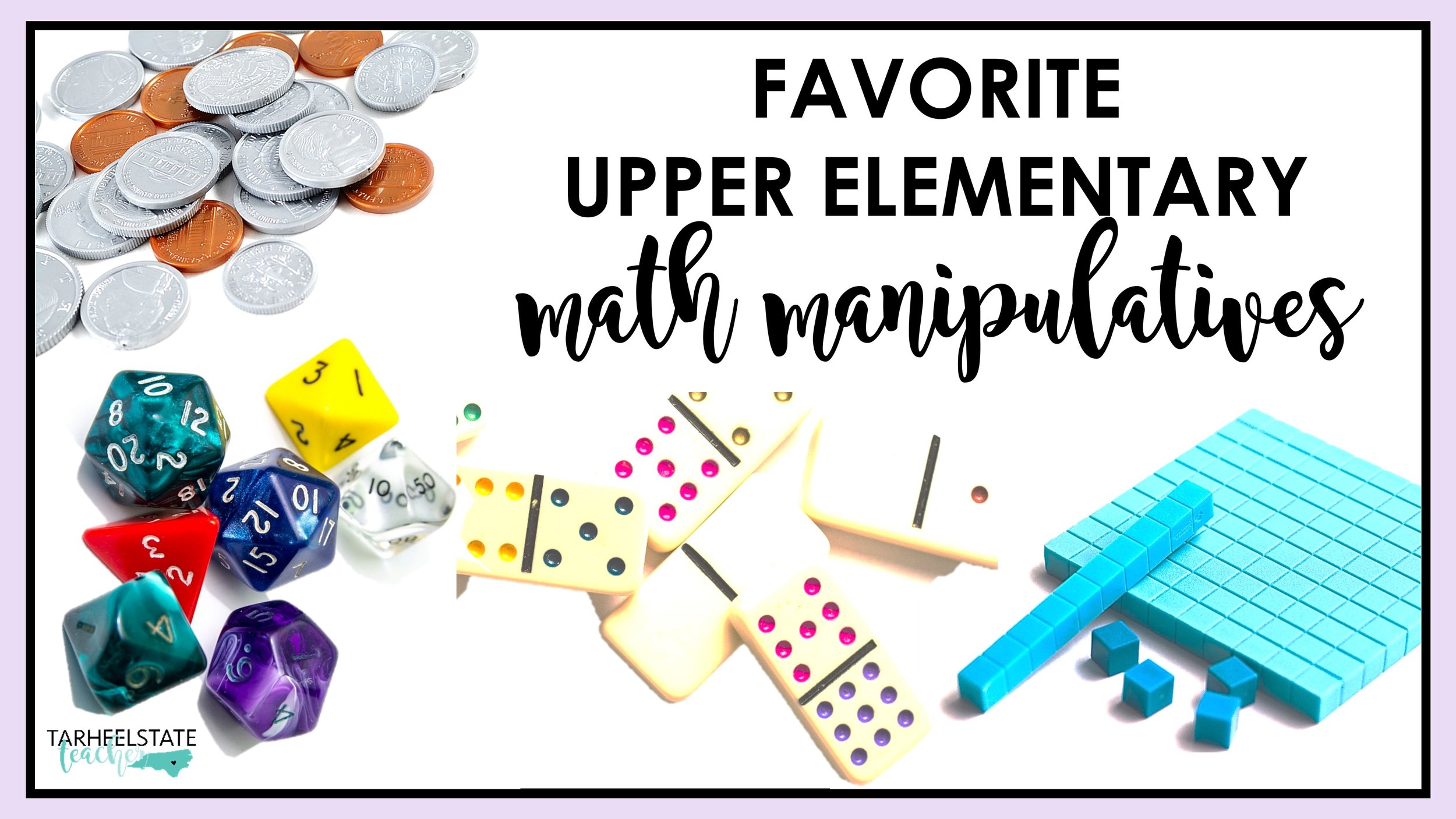"Must Have" Math Manipulatives for Upper Elementary
Today I'm sharing my love of math manipulatives with you. Having a variety of manipulatives for math "at the ready" in my 4th grade and 5th grade classroom is critical for inspiring ideas for hands-on math games and activities. Different manipulatives give me the opportunity to design games and lessons at different levels for scaffolding and differentiation that helps students build on their understanding of a math concept.
For many of these manipulatives, it wasn’t until I had access to a class set that I considered them a "game-changer" for my math instruction.
(Doesn't it STINK when having access to materials holds you back from doing awesome things in your classroom?!?) With class sets, I found that I could implement ideas with manipulatives without worrying about having enough materials. I could introduce games and activities during whole group instruction and later move them into stations or use them when students finished assignments later in the week.
A few years ago, I was lucky enough to land in a classroom that had access to tons of math manipulatives. Seriously, I spent the entire summer cleaning out that classroom and organizing #allthethings. For some of the math manipulatives I had available, I was truly unaware of their benefits in a 4th or 5th grade classroom.
However, having access to these materials (many in quantities great enough for each student to have their own materials) truly opened my mind to many of the ways I could incorporate them into my math lessons.
I keep many of the manipulatives I’m highlighting below available to grab at a second's notice when I'm working with students on different concepts. The more you use these manipulatives in your classroom, the more you will find yourself being prepared for "on the fly" differentiation that helps students "see" concepts versus just showing them again and again with pencil and paper.
Note: Some of the links in this post are affiliate links. This means that I am a participant in the Amazon Services LLC Associates Program, an affiliate advertising program designed to provide a means for sites to earn advertising fees by advertising and linking to amazon.com. Read my full disclosure here.
If you do not have access to some of the manipulatives I share in this post, I would really encourage you to get class sets of what you can afford (beg your principal?!) and at least purchase one set for yourself to play with to design games and activities. Ask around the school and perhaps you can borrow what you need for a while.
Let's get to the fun stuff:
RECOMMENDED MATH MANIPULATIVES FOR 4TH GRADE/5TH GRADE:
1) Base 10 Blocks
I love having enough base-10 blocks at my disposal for students to use. I use base-10 blocks during whole number operations units (place value, comparing numbers, adding and subtracting, etc) but I also bring them out again during fractions and decimal units. Instead of the 100's block being 100, it is now our "whole." Using "10 sticks" and ones cubes, students develop better understanding of tenths and hundredths. I've also seen lessons using these for multiplication, area, and the area model.
Do 4th or 5th graders really need to "play" with base-10 blocks?
Yes, I think they do! One way we "played" with base 10 blocks at the beginning of the year was with our "Place Value Houses" activity.
2) Dice (in many varieties!)
FOR THE LOVE OF DICE! Dice come in so many shapes and sizes, I truly did not know all of the variety until I came across different ones in my new classroom.
The standard 6-sided dice are great for math games, but 10 sided dice are a game changer for easy differentiation.
I've now got dice that range 1-2, fractions dice, and dice with the four operations, equals, and a comparison sign. Check them out on Amazon! You may find dice for math that you can’t live without!
I also found place value dice on amazon that have one dice each for "ones, tens, hundreds, thousands, ten thousands, hundred thousands, millions, tenths, hundredths, and thousandths. Each die is ten-sided so students can generate every possible number between 0 and 9,999,999.999."
(WOW oh WOW!). Seriously. A class set of these are a a game-changer for my place value, expanded form, standard form, comparing numbers, and value of the digits lessons. To differentiate, I can just have students who need to start small remove the dice for larger numbers and decimals. I just added those to my cart and can't wait to play around with them! BE STILL MY MATH HEART!
Have any favorite dice for math of your own? Let me know in the comments!
3) "Play" Money (especially dimes and pennies)
So, true story. When I switched schools, the classroom I took over was full of play money. Dimes, pennies, nickels, all over the place.
I could not for the LIFE OF ME figure out why a 4th grade classroom had "play" money.
Money is a lower-grades standard, right?
Well, when we got to our fractions and decimals units, I had students using bags of money A LOT. This is one of the {very important} manipulatives that I would keep close by during my decimal lessons.
When students made mistakes like "1/100 > 1/10," I would bring them a bag of money and ask them, "Which coin is 1/100 of a dollar? Which coin is 1/10 of a dollar? Which coin has a greater value?"
When students compared decimals (.08 compared to .3) and chose the wrong number, I'd have them represent each decimal with money, discuss the value of the monetary representation, and then explain how they knew which decimal number was larger. By bringing out the money, I was able to continuously address misconceptions and help students develop their concept of decimals. This, combined with our classroom lessons continuously reinforced their understanding of decimals.
4) Fraction Manipulative Sets
Okay, I’ve already shared that I was lucky at my school, but in this case, I felt SUPER spoiled. I was able to request a CLASS SET of plastic fraction circles. The realllly good fraction set is the one that has a plastic container to put the pieces in. These were in short supply when I purchased mine, so I had to supplement with the fraction sets that just come in a plastic bag.
(I've read some research about having students create their own representations of fractions with paper, and I'm not going to debate the value of that, but I will say, no one can really contest the benefits of having ready-made fraction manipulatives that students are able to get their hands on again and again to bring fraction concepts to life during math lessons. Manipulatives in the hands of a good teacher are never bad, in my opinion. And, ready made fractions manipulatives are better than using NO manipulatives at all, seriously.)
Yes—in 4th grade and 5th grade, students still need to touch fractions!
With my 4th graders, nearly every lesson at the beginning of our fractions unit started with me prompting them to do something with their fractions sets. I recommend giving each student a ziploc bag, having them write their name on it, and giving them the same set of fractions manipulatives each time you use them. This way, a students’ messy manipulatives are their mess; if they lose pieces (cringe), they have to be the one to deal with not having what they need.
Some examples of fractions prompts I’ve used include:
create all of the equivalent fractions you can (students often eye-ball these; you can have discussions about whether or not the fractions are equivalent or “close” in size. In later lessons, use mathematical operations and proof to decide if the fractions are equivalent)
make 1 whole all the ways you are able to
find all the ways you can make 1/2 (3/4, 2/3, etc).
model equations that equal 7/8 as many ways as you can using only eighths (to work on decomposing fractions)
using fraction models and words, explain why 2/3 + 2/3 ≠ 4/6
Note: I prompt with these directions on the smart board and students record their answers in their math journals.
5) Decks of Playing Cards
Decks of playing cards can be used for so many math activities! The range of digits from 1-10 (making an Ace a 1) make them perfect for place value lessons, comparing whole numbers, multiplication or division war, and more! You can remove the face cards or make them "wild cards" where students can choose the number they'd like to use. Whip up a quick playing mat OR let students draw on their desks with Expo markers for even more excitement.
Playing cards would be a PERFECT thing to add to your back to school supply list to easily get your class sets, or grab them at the dollar store (if you are Type A and would want all of them to be of the same quality!) I'm game for shopping around and finding 25 different and CUTE decks of cards so that we can keep them all separate.
One of my most favorite ways to incorporate playing cards into my fractions unit was when we played a comparing fractions card game. As we were playing, I figured out different ways to scaffold and help my students increasingly develop their ability to compare more challenging fractions. (You can check out all the rounds I used for the game in this blog post.)
6) Dominoes
I haven't incorporated dominoes a lot into my math activities, but THEY LOOK LIKE FRACTIONS, so what am I waiting for?
Perhaps it's because I've never had a class set of dominoes, but I want to grab some so that I can play around and come up with new ideas. This domino set looks awesome. It contains 15 sets in 6 different colors. This is another item you can grab at the dollar store too! And don't even get me started on the domino sets designed specifically for math activities-- fraction dominoes, polygon dominoes (I have something similar to this)! Students can even make their own Domino activities! The possibilities are endless!
Have you read this post and still feel unsure of how to really use math manipulatives in your math classroom?

I didn't give you a ton of ideas in this blog post...I am just getting started and plan to share more ideas for using these math manipulatives for different concepts...
but, MY ADVICE: Don't wait until you "know" how you will use these math manipulatives to get your hands on them. Start collecting and buying to build yourself class sets of these tools for math (if you are not lucky enough to have them given to you or purchased by your school).
—> Many of the ways I figured out to use these manipulatives in my lessons only happened because I had ACCESS to them.
Pinterest is also a great tool to use when trying to come up with ideas! Search for ideas on the topics you are covering and I just know you will find some way to engage your students in a more hands-on math block!
I've created a list of some of these favorite math manipulatives on amazon! You can check out all of my recommendations by clicking here!
I know there are other math manipulatives that some teachers would consider crucial, but these are my favorite 6. What other manipulatives should I add to my upper elementary toolbox?
Want more helpful math stations tips? Check out these posts about Math Stations:
⇒ An Overview of My Upper Elementary Math Stations
⇒ 5 Rules for Math Stations...that you can break!
⇒ Math Station Essentials {Tools for Organization and Management}
⇒ Organizing Your Math Stations Schedule: Math Stations Rotation Template









